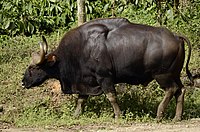
Photo from wikipedia
Abstract Sub-optimal productivity in cashew is common in tropical India due to inadequate attention on plant nutrient management. Identifying the nutrient constraints, its diagnosis and management are important for maximizing… Click to show full abstract
Abstract Sub-optimal productivity in cashew is common in tropical India due to inadequate attention on plant nutrient management. Identifying the nutrient constraints, its diagnosis and management are important for maximizing production in a sustainable manner. We established nutrient diagnostic norms for cashew that shall be useful for quick diagnosis of the nutrient requirement of cashew for devising rapid nutrient management schedule to improve the productivity. The optimal leaf nutrient status in cashew for nitrogen, phosphorus, potassium, calcium, magnesium and sulfur ranged from 2.23 to 2.82, 0.13 to 0.18, 0.91 to 1.47, 0.92 to 1.39, 0.46 to 0.70 and 0.75 to 1.14% respectively. The optimal leaf status for micronutrients such as iron, manganese, zinc, copper, boron and molybdenum ranged as 285 to 398, 200 to 409, 54 to 74, 47 to 60, 22 to 46 and 3.0 to 4.4 mg kg−1. The regional survey on soil and leaf nutrient status of cashew in prominent cashew growing areas along coastal India revealed the nutrient constraints causing lower productivity levels. The cashew growing soils in India were predominantly deficient in nitrogen, potassium, calcium, magnesium, zinc and copper. The study indicated the ill effects of neglect of fertilizer and manure application in cashew on soil organic carbon, nitrogen and potassium, which adversely affected the nutrient uptake by cashew as evident from the leaf nutrient status. The study also highlighted the need to pay attention to soil ameliorants to correct soil acidity to make available calcium, magnesium and micronutrients such as zinc, copper and manganese.
Journal Title: Journal of Plant Nutrition
Year Published: 2021
Link to full text (if available)
Share on Social Media: Sign Up to like & get
recommendations!